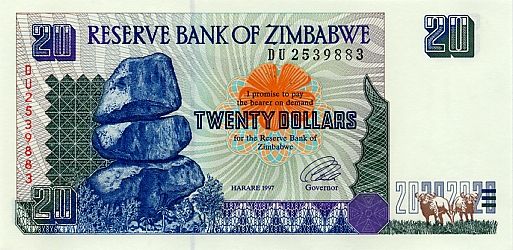Historical Background of Zimbabwe’s Currency
Zimbabwe’s currency history is marked by periods of economic upheaval and hyperinflation, culminating in the issuance of the infamous 10 trillion dollar note. Originally, the country used the Rhodesian pound before transitioning to the Zimbabwean dollar in 1980. Over the years, economic instability and political challenges led to rapid devaluation of the currency, eventually resulting in one of the highest denominations ever produced during the hyperinflation crisis of the late 2000s. This history reflects the tumultuous financial landscape that prompted drastic measures, including printing exorbitant currency denominations like the 10 trillion dollar note.
The Onset of Hyperinflation in the 2000s
The historical background of Zimbabwe’s currency is marked by periods of economic instability and hyperinflation, culminating in the issuance of the iconic 10 trillion dollar banknote. Initially, Zimbabwe adopted a stable currency system derived from the Rhodesian dollar, but economic challenges, political instability, and land reforms in the late 20th century gradually undermined fiscal stability. These issues led to a decline in confidence in the local currency, prompting increased printing of money to finance government expenditures.
The onset of hyperinflation in the 2000s was primarily driven by a combination of excessive money supply, dwindling productive capacity, and economic mismanagement. As inflation skyrocketed, prices doubled rapidly, with the government resorting to printing more money to cover debts and deficits. This spiral resulted in hyperinflation peaking in 2008, when Zimbabwe experienced one of the most severe cases in monetary history, with inflation rates reaching into the billions percent per month.
During this turbulent period, the Reserve Bank of Zimbabwe issued increasingly larger denominations, culminating in the famous 10 trillion dollar note in 2008, symbolizing the extent of hyperinflation. These banknotes quickly lost value, making daily transactions difficult and eroding savings. The hyperinflation crisis ultimately rendered the Zimbabwean dollar nearly worthless, leading to the dollarization of the economy and the abandonment of the local currency in 2009. This period remains a stark reminder of the destructive effects of unchecked inflation and economic mismanagement.
Transition from Zimbabwean Dollar to Foreign Currencies
The Zimbabwean dollar has a complex history characterized by periods of hyperinflation and economic instability, culminating in one of the most notable instances being the 10 trillion dollar note. Originally introduced in 1980, replacing the Rhodesian dollar, the currency faced severe challenges during the late 20th and early 21st centuries. Hyperinflation reached unprecedented levels, peaking in 2008, when inflation rates soared, rendering the local currency virtually worthless. As a result, the Reserve Bank of Zimbabwe issued increasingly larger denominations, including the infamous 10 trillion dollar note, as a measure to cope with the rapid devaluation. Ultimately, due to the persistent inflation and loss of confidence in the Zimbabwean dollar, the country transitioned to using foreign currencies such as the US dollar and the South African rand in 2009. This move helped stabilize the economy by restoring trust and facilitating international trade, ending the era of hyperinflation and the use of the Zimbabwean dollar as the primary medium of exchange. The abandonment of the local currency marked a significant turning point in Zimbabwe’s monetary history, highlighting the impacts of economic mismanagement and the importance of stable currency policies.
The Rise to a $10 Trillion Banknote
The journey to a $10 trillion banknote in Zimbabwe represents one of the most remarkable episodes in modern economic history. Amid hyperinflation and economic instability, Zimbabwe issued an unprecedented banknote denomination to cope with soaring prices, capturing global attention and raising questions about the challenges of managing currency during times of crisis.
Economic Factors Leading to Massive Denominations
The rise to a $10 trillion banknote in Zimbabwe is a significant example of how economic factors can lead to the issuance of extraordinarily large denominations. This phenomenon is primarily driven by hyperinflation, economic instability, and loss of confidence in the local currency, forcing the central bank to create higher denominations to facilitate everyday transactions.
- Hyperinflation: Zimbabwe experienced hyperinflation starting in the early 2000s, with inflation rates soaring to levels where traditional banknotes became insufficient for daily commerce.
- Loss of Currency Value: Rapid depreciation of the Zimbabwean dollar eroded the currency’s value, prompting the issuance of higher denomination notes to keep pace with price increases.
- Economic Instability: Political turmoil, declining agricultural productivity, and economic sanctions contributed to economic instability, exacerbating inflationary pressures.
- Monetary Policy Response: The central bank’s strategy involved printing larger denominations, including the $10 trillion note, to meet the demands of a rapidly expanding money supply.
- Public Necessities and Transactions: As prices soared, everyday items and services required larger bills, leading to the proliferation of banknotes with extremely high denominations.
The issuance of a $10 trillion Zimbabwean dollar note exemplifies how extreme inflationary spirals can distort monetary systems, leading to the need for colossal currency denominations to sustain economic activity amidst chaos.
Production and Distribution of the $10 Trillion Note
The rise to a $10 trillion banknote in Zimbabwe’s history is a significant example of hyperinflation and economic instability. During the late 2000s, Zimbabwe experienced extreme inflation rates, leading the Reserve Bank of Zimbabwe to produce extraordinarily high denominations to cope with rapidly depreciating currency values. The $10 trillion note became a symbol of the country’s economic crisis, representing the dramatic decline in purchasing power and confidence in the local currency.
The production of the $10 trillion note involved printing vast quantities of banknotes with highly complex security features to prevent counterfeiting. Central bank authorities had to continuously increase the note denominations to meet the demands of a collapsing economy. The manufacturing process was facilitated by specialized printing companies, often outsourcing production to high-security printing firms capable of producing such large value notes.
Distribution of the $10 trillion banknotes was predominantly through official channels, including banks and currency exchanges, but their lowness in utility was evident as hyperinflation rendered the currency practically worthless. Citizens often carried large stacks of these banknotes for everyday transactions, reflecting the loss of confidence in the monetary system. Eventually, Zimbabwe abandoned its Zimbabwean dollar for foreign currencies and introduced monetary reforms to stabilize the economy, marking the end of the era of such colossal banknotes.
Design and Features of the $10 Trillion Zimbabwean Note
The $10 trillion Zimbabwean note stands as a remarkable example of hyperinflation and economic turmoil in the country’s recent history. Designed with intricate security features and vibrant imagery, this banknote reflects Zimbabwe’s efforts to combat runaway inflation and restore confidence in its monetary system. Despite its astronomical denomination, the note is also a symbol of the nation’s resilience and the challenges faced during its period of economic instability.
Aesthetic Elements and Symbolism

The $10 trillion Zimbabwean note stands out as a striking example of hyperinflation-era currency, combining innovative design and rich symbolism. Its size and vivid coloration emphasize the monumental value it intended to convey during a period of economic crisis. The front features detailed portraits of Zimbabwean historical figures, symbolizing national pride and resilience amidst challenging times. Intricate patterns and borders incorporate traditional African art motifs, highlighting cultural heritage and unity.
Aesthetic elements of the note include elaborate geometric designs, vibrant security features, and watermarks that enhance its visual appeal and countercounterfeit measures. The use of bright colors such as green, yellow, and red evokes themes of growth, vitality, and sacrifice that are central to Zimbabwe’s identity. The back of the note showcases landscapes of Zimbabwe, such as the majestic Victoria Falls, evoking natural beauty and the country’s rich environmental history.
Overall, the design and features of the $10 trillion Zimbabwean note reflect a blend of artistic craftsmanship and deep symbolism. They serve not only as a medium of exchange but also as a narrative of national perseverance and cultural pride amid economic turmoil.
Security Features and Anti-Counterfeiting Measures
The 10 trillion Zimbabwean dollar note is a remarkable piece of currency history, highlighting the country’s period of hyperinflation. Its design is both bold and intricate, featuring vibrant colors and large denominations that emphasize its unprecedented face value. The note displays prominent figures and national symbols to reinforce its authenticity and national pride. Security features are meticulously incorporated to prevent counterfeiting, including watermarks, security threads, color-shifting inks, and holographic elements. Anti-counterfeiting measures also involve complex microtext, latent images, and intricate border designs that are difficult to reproduce accurately. These features collectively ensure the integrity of the currency amidst significant economic challenges faced during its circulation, making the 10 trillion dollar note a unique artifact of Zimbabwe’s economic history and currency security innovation.
Economic Impact of a $10 Trillion Banknote
The introduction of a $10 trillion banknote in Zimbabwe signifies a remarkable and unprecedented event in the nation’s economic history. This massive denomination reflects the extent of hyperinflation experienced and highlights the challenges faced by the country’s monetary system. Understanding the economic implications of such a significant banknote provides insight into Zimbabwe’s financial recovery efforts, inflation dynamics, and broader impacts on its economy and society.
Inflation and Currency Devaluation Effects
The issuance of a $10 trillion banknote by Zimbabwe signifies a profound economic development with far-reaching implications. Such a colossal denomination often reflects attempts to address hyperinflation and stabilize the monetary system, but it can also trigger significant inflationary pressures. When the government prints large denominations, it frequently signals an erosion of confidence in the currency, leading to rapid price increases as people seek to convert cash into more stable assets. This scenario can create a vicious cycle of devaluation, where the currency’s value plummets, and prices soar, diminishing the purchasing power of ordinary citizens.
Inflation resulting from such high-denomination banknotes erodes savings, discourages investment, and hampers economic growth. Consumers face uncertainty, as the real value of their income declines sharply, reducing consumption and slowing economic activity. Additionally, a devalued currency complicates international trade, as imports become more expensive and exports less competitive, further straining the country’s economy. The use of a $10 trillion banknote in Zimbabwe reflects the depth of economic instability, and without comprehensive reforms, it risks perpetuating a cycle of inflation and devaluation, ultimately undermining economic stability and social well-being.
Public Confidence and Currency Usage
The issuance of a $10 trillion banknote by Zimbabwe represents a significant event in the nation’s economic history, reflecting its ongoing struggle with hyperinflation and monetary instability. Such a large denomination aims to facilitate daily transactions in an economy where prices escalate rapidly, but it also raises concerns about the long-term sustainability of the currency system.
From an economic perspective, introducing a $10 trillion note can temporarily bolster liquidity and ease transactional difficulties. However, it may also lead to further loss of confidence among the public and international observers if not accompanied by credible economic reforms. High-denomination notes in hyperinflationary contexts often symbolize a failing currency to users, impacting trust and stability.
Public confidence plays a crucial role in the effective usage of currency. When citizens perceive the currency as unreliable and prone to devaluation, they tend to seek alternative stores of value such as foreign currencies or commodities, undermining the domestic currency’s utility. A $10 trillion banknote may be viewed as a desperate measure, reinforcing perceptions of economic disarray.
Currency usage under these circumstances tends to shift from formal to informal sectors, diminishing the demand for official currency and complicating monetary policy implementation. Continued reliance on high denominations without structural reforms can entrench hyperinflation, further eroding savings, discouraging investment, and stalling economic growth.
Overall, while the introduction of a $10 trillion banknote in Zimbabwe addresses immediate transactional needs, its broader implications highlight the importance of stabilizing economic fundamentals, restoring public confidence, and promoting sustainable monetary policies for long-term economic health.
Comparison with Other High-Denomination Banknotes
The 10 trillion dollar banknote of Zimbabwe stands out as one of the most notable examples of hyperinflation-induced currency denominations in history. When compared to other high-denomination banknotes, it highlights the extraordinary economic turmoil that Zimbabwe experienced during its inflation crisis. Examining these banknotes reveals insights into how nations have responded to financial instability and the limits of traditional currency systems in times of crisis.
Global Instances of Hyperinflation Currency Notes
The 10 trillion dollar banknote from Zimbabwe is a striking example of hyperinflation’s impact on a nation’s currency, highlighting the extreme devaluation that occurred during that period. Unlike high-denomination banknotes in other countries, Zimbabwe’s note became a symbol of economic collapse, with its colossal face value representing the desperation of a failing economy. Comparatively, hyperinflation episodes in nations like Weimar Germany with its 100 trillion mark or the hyperinflation in Yugoslavia featuring the 500 billion dinar note showcase similar scenarios where soaring inflation rendered currency practically worthless. These instances reveal a pattern where excessive money printing and loss of confidence in the currency lead to the issuance of increasingly higher denominations. While other hyperinflation notes, such as the Hungary Pengo or the Zimbabwean 10 trillion dollar, demonstrate the severity of economic crises, Zimbabwe’s inflation surpasses many others in both scale and public perception, emphasizing the devastating effects of uncontrolled monetary expansion globally.
Unique Aspects of Zimbabwe’s $10 Trillion Note
The Zimbabwe $10 trillion banknote stands out among high-denomination currency notes due to its extreme face value resulting from hyperinflation, unlike other high-denomination bills used in different countries which often reached similar denominations for practical reasons. While notes such as the German Papiermark during hyperinflation in the 1920s or the Yugoslav dinar in the 1990s also achieved high denominations, Zimbabwe’s note is particularly notable for its record-breaking face value, symbolizing the severity of its economic crisis. Unique to the Zimbabwean $10 trillion note is its role as a tangible artifact of economic collapse rather than just a functional currency, representing an unprecedented level of inflation and a dramatic shift in monetary policy. Its design and issuance also reflect the desperation for currency stabilization, setting it apart from high-denomination notes that were part of controlled monetary expansion or wartime economies. Ultimately, the Zimbabwe $10 trillion note epitomizes a unique intersection of economic instability and historical significance, distinguishing it from other high-denomination banknotes in global monetary history.
Current Status and Aftermath
The current status and aftermath of Zimbabwe’s 10 trillion dollar currency situation reflect a nation grappling with profound economic challenges. This massive inflation has significantly impacted daily life, causing widespread instability and uncertainty. Understanding the aftermath reveals the resilience of the people and ongoing efforts toward economic stabilization in the face of extraordinary financial upheaval.
Reintroduction of Multi-Currency System
The reintroduction of a multi-currency system in Zimbabwe marked a significant turning point in its economic recovery efforts following a period of hyperinflation and currency instability. This move allowed the country to stabilize prices, restore public confidence, and facilitate trade by enabling the use of multiple foreign currencies alongside the local Zimbabwean dollar. The current status sees increased foreign investment and gradual economic growth, though challenges such as inflationary pressures and currency devaluation persist. The aftermath of implementing the multi-currency system has been mixed; while it successfully curtailed hyperinflation and improved transaction ease, it also exposed vulnerabilities linked to reliance on external currencies. Overall, the reintroduction aimed to restore stability and lay the foundation for sustainable development, with ongoing efforts required to strengthen economic resilience and manage monetary policy effectively amidst global and domestic pressures.
The Role of Digital Payment Systems in Zimbabwe
The current status of Zimbabwe’s digital payment systems plays a crucial role in stabilizing the country’s economy, especially amid the backdrop of hyperinflation that reached an astonishing 10 trillion dollars. Digital platforms have become essential for everyday transactions, offering a reliable alternative to cash and helping to curb the effects of currency devaluation. These systems facilitate mobile money transfers, online banking, and electronic payments, making financial access more inclusive and reducing reliance on physically unstable currency notes.
In the aftermath of the hyperinflation crisis, Zimbabwe has seen significant reforms aimed at integrating digital payment methods to restore confidence in the financial sector. Digital payment systems have contributed to improving economic stability by streamlining transactions, increasing transparency, and fostering safer financial practices. They also support economic recovery by encouraging digital literacy and broadening financial inclusion among the previously unbanked populations. Moving forward, continued investments in digital infrastructure are likely to be vital in ensuring sustained growth and resilience in Zimbabwe’s economy, sidestepping the destructive inflation of the past and promoting a more stable financial future.





0 Comments